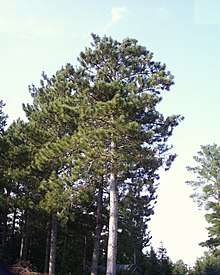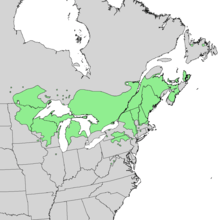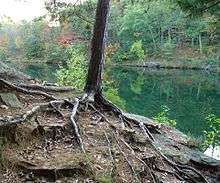Pinus resinosa
| Red pine | |
|---|---|
 | |
| Trees at Sherburne NWR, Minnesota | |
| Scientific classification | |
| Kingdom: | Plantae |
| Division: | Pinophyta |
| Class: | Pinopsida |
| Order: | Pinales |
| Family: | Pinaceae |
| Genus: | Pinus |
| Subgenus: | P. subg. Pinus |
| Section: | P. sect. Pinus |
| Subsection: | P. subsect. Pinus |
| Species: | P. resinosa |
| Binomial name | |
| Pinus resinosa | |
 | |
Pinus resinosa, known as red pine[1][2] or Norway pine, is a pine native to North America. It occurs from Newfoundland west to Manitoba, and south to Pennsylvania, with several smaller, disjunct populations occurring in the Appalachian Mountains in Virginia and West Virginia, as well as a few small pockets in extreme northern New Jersey and northern Illinois.[3][4]
Description
Red pine is a coniferous evergreen tree characterized by tall, straight growth in a variety of habitats.[5] It usually ranges from 20–35 m (66–115 ft) in height and 1 m (3 ft 3 in) in trunk diameter, exceptionally reaching 43.77 m (143 ft 7 in) tall.[6] The crown is conical, becoming a narrow rounded dome with age. The bark is thick and gray-brown at the base of the tree, but thin, flaky and bright orange-red in the upper crown; the tree's name derives from this distinctive character. Some red color may be seen in the fissures of the bark. The species is self pruning; there tend not to be dead branches on the trees, and older trees may have very long lengths of branchless trunk below the canopy.
The leaves are needle-like, dark yellow-green, in fascicles of two,[5] 12–18 cm (4 3⁄4–7 in) long, and brittle. The leaves snap cleanly when bent; this character, stated as diagnostic for red pine in some texts, is however shared by several other pine species. The cones are symmetrical ovoid, 4–6 cm (1 1⁄2–2 1⁄4 in) long by 2.5 cm (1 in) broad, and purple before maturity, ripening to nut-blue and opening to 4–5 cm (1 1⁄2–2 in) broad, the scales without a prickle and almost stalkless.[1]
Red pine is notable for its very constant morphology and low genetic variation throughout its range, suggesting it has been through a near extinction in its recent evolutionary history.[7][8] A genetic study of nuclear microsatellite polymorphisms among populations distributed throughout its natural range found that red pine populations from Newfoundland are genetically distinct from most mainland populations, consistent with dispersal from different glacial refugia in this highly self-pollinating species.[9]
Ecology
It is intolerant of shade, but does well in windy sites; it grows best in well-drained soil. It is a long-lived tree, reaching a maximum age of about 500 years.[10] The wood is commercially valuable in forestry for timber and paper pulp, and the tree is also used for landscaping.
Culture
The red pine is the state tree of Minnesota.[11]
 An old tree in Itasca State Park, Minnesota
An old tree in Itasca State Park, Minnesota Pollen cones in spring
Pollen cones in spring- Cone (scale in cm)
 Red pine boughs, showing yellowing and abscission of older foliage in the autumn.
Red pine boughs, showing yellowing and abscission of older foliage in the autumn.
References
- 1 2 Moore, Gerry; Kershner, Bruce; Tufts, Craig; Mathews, Daniel; Nelson, Gil; Spellenberg, Richard; Thieret, John W.; Purinton, Terry; Block, Andrew (May 9, 2008). National Wildlife Federation Field Guide to Trees of North America. New York: Sterling Publishing. p. 66. ISBN 978-1-4027-3875-3.
- ↑ "Red Pine". Minnesota Department of Natural Resources.
- ↑ Conifer Specialist Group (1998). "Pinus resinosa". IUCN Red List of Threatened Species. Version 2006. International Union for Conservation of Nature. Retrieved 12 May 2006.
- ↑ Hilty, John (2016). "Pinus resinosa". Illinois Wildflowers. Retrieved May 1, 2017.
- 1 2 Kral, Robert (1993). "Pinus resinosa". In Flora of North America Editorial Committee. Flora of North America North of Mexico (FNA). 2. New York and Oxford – via eFloras.org, Missouri Botanical Garden, St. Louis, MO & Harvard University Herbaria, Cambridge, MA.
- ↑ Earle, Christopher J., ed. (2018). "Pinus resinosa". The Gymnosperm Database. Retrieved 5 February 2012.
- ↑ Fowler, D. P.; Morris, R. W. (1977). "Genetic diversity in Red Pine: evidence for low genic heterozygosity". Canadian Journal of Forest Research. 7 (2): 343–347. doi:10.1139/x77-043.
- ↑ Simon, Jean-Pierre; Bergeron, Yves; Gagnon, Daniel (1986). "Isozyme uniformity in populations of Red Pine (Pinus resinosa) in the Abitibi Region, Quebec". Canadian Journal of Forest Research. 16 (5): 1133–1135. doi:10.1139/x86-198.
- ↑ Jacquelyn Boys, Marilyn Cherry, Selvadurai Dayanandan (2005). "Microsatellite Analysis Reveals Genetically Distinct Populations of Red Pine". American Journal of Botany. 92 (5): 833–841. doi:10.3732/ajb.92.5.833. Retrieved May 1, 2017.
- ↑ http://www.ldeo.columbia.edu/~adk/oldlisteast/#spp
- ↑ "State Tree- Norway Pine". Minnesota Secretary of State.
External links
![]()
